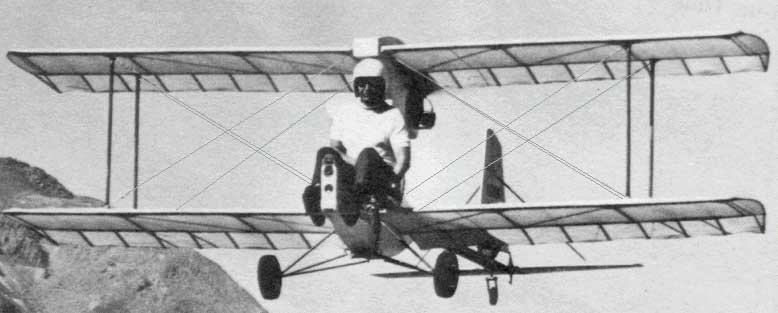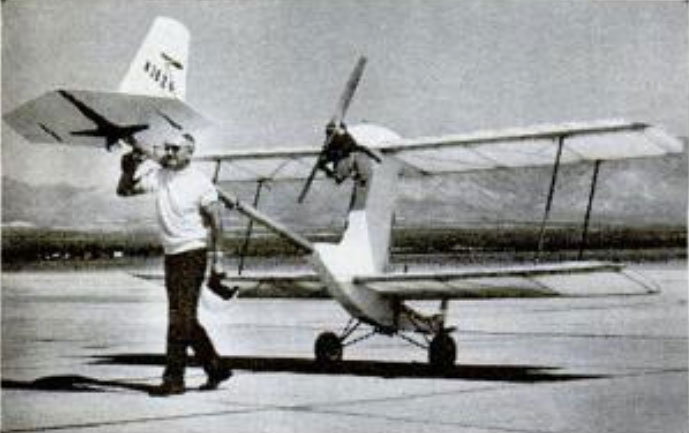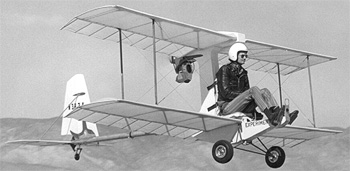Original article by Paul Wahl, edited by Tinker Source.
This ultralight sport biplane is a flying go-kart!
Sitting up front, out in the open, you feel like an intrepid birdman of the Wilbur and Orville era–and you’re still on the ground! Riding the Whing Ding is like that. While one of your ground crew braces the aircraft against premature launching (there’s about 60 lbs. of thrust and no brakes), his partner reaches up and yanks the pull-start cord. Unbelievably loud-mouthed for its 15 HP rating, the little single-cylinder go-kart engine behind you comes on with a throaty roar, spinning the 4-foot pusher prop. The ground crew steps aside, turning the Whing Ding loose, and you’re on your own!
Takeoff
You hit the throttle and as the plane moves forward, picking up speed, the tail comes up quickly. After a run of around 250 feet, the Whing Ding is airborne. It climbs at a fairly slow rate to 20 feet, where you level off. Of course, you can go much higher, but most Whing Ding pilots are content to cruise at low altitude—it feels three times as high anyway.
Throttle wide open, you move along at 45 mph. It’s quite a thrill and a bit scary to look down—with nothing but your feet in front of you—and see the ground below whizzing by. Lack of visual reference takes some getting used to. There are no instruments, so you fly the Whing Ding by the seat of your pants.
Flying
Flying an oval course, making gently banked turns (there isn’t enough power for steep ones), you find that the Whing Ding handles very nicely, and is stable about all three axes. Any light-plane pilot with about 20 hours of solo time in tail draggers should be able to fly it. While the Wing Ding can take gusts of up to 10 knots, like other ultralights it’s really intended for flying on calm days.
The half-gallon tank holds enough fuel for a 15 minute flight. When it’s time to throttle down, you back off on the throttle and start your descent, slowing to 25 mph at touchdown. Power off, you taxi to a stop; wing drag contributes some braking effect.
Conclusion
This is a “portable” plane. For the trip home from the flying field, you remove the wings (disassembly for transport is a 15 minute job) and load the aircraft aboard a small trailer or pickup truck.
With a 17 foot wingspan, the Whing Ding weighs only 122 pounds (empty), making it the world’s lightest man-carrying airplane with an engine. Maximum pilot weight is 185 lbs.

Above picture:
The Whing Ding 2 bounds into the air like a happy grasshopper.

Above picture:
“Taxiing” the Whing Ding is simplicity itself. Just pick up the tail of the 120 lb aircraft and drag it where ever you want it. The wings can be removed in 15 minutes so you can take it home with you.
You can get plans to build the Whing Ding 2 for only $14.99 here.


Comments on this entry are closed.